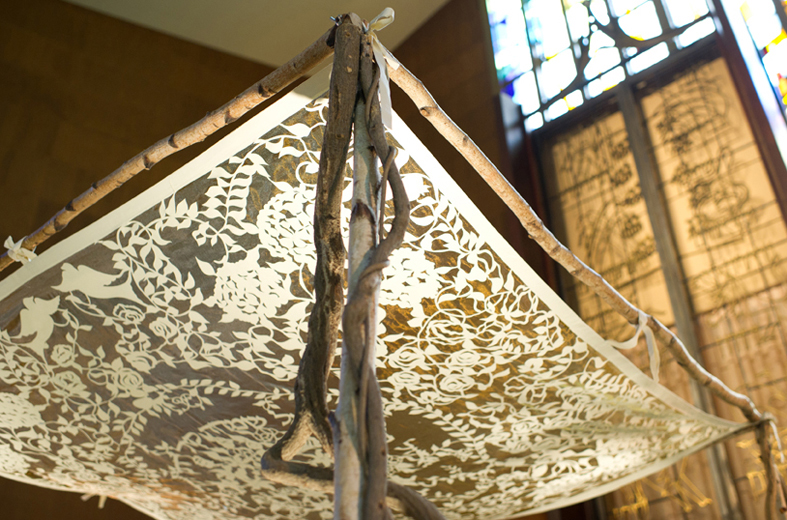A Jewish wedding takes place under a huppahMarriage canopy symbolizing the couple's new home., a canopy symbolic of the couple’s first home, open on all four sides as the couple’s home will be open to friends, family and needy strangers. The chuppah’s presence above the bride and groom also symbolizes the ShekhinahThe feminine name of God, expounded upon in the rabbinic era and then by the Kabbalists in extensive literature on the feminine attributes of the divine., God’s indwelling presence, which hovers close to the bride and groom on this most magical of days.
In talmudic times, the huppah was literally a tent under which the wedding was consummated. While this custom gradually disappeared, the huppah remained and evolved.
There are no particular dimensions to a huppah or specifications for the material. Some couples getA writ of divorce. Traditionally, only a man can grant his wife a get. Liberal Jews have amended this tradition, making divorce more egalitarian. married under a tallitA four-cornered garment to which ritual fringes (tzitzit/tzitzi'ot) are affixed. The knots in the fringes represent the name of God and remind us of God's commandments. The tallit is worn during prayer and can also be drawn about oneself or around the bride and groom to symbolize divine protection., a prayer shawl; others use a family heirloom like a tablecloth. Some synagogues own decorated huppot which are lent out for weddings. And finally some couples design their own. A huppah can be batiked, woven, embroidered, silk-screened, appliqued, caligraphed or painted, to name a few possibilities.
One new tradition is to send guests cloth squares on which they are asked to create something for the bride and groom. The squares are then mailed to someone who assembles them in a beautiful and unique huppah.
Some huppot are stationary and will be set up prior to the wedding on the dais or wherever the bride and groom will stand. Some are portable and carried in on poles as part of the wedding procession. It is a great honor to hold someone’s huppah at their wedding.
Circling
There is a tradition, though not legally mandated, of the bride circling the groom under the huppah immediately following the processional. Some brides circle three times and some seven. Some find the ritual objectionable, seeing it as symbolic of the bride’s subservience. Today couples often circle one another, 3x each and then one “do-si-do.”
There are many interpretations of this custom. One is that while the huppah, with its open sides, represents the interdependence between the couple and the community, the circle marks off holy, private space where only the bride and groom stand.
It is appropriate to play music during the circling. The following chant, written by Linda Hirschorn, can be sung.
Circle round for freedom
Circle round for peace
For all of us in prison
Circle for release.
Circle for the planet
Circle for each soul,
For the children of our children
Keep the circle whole.











